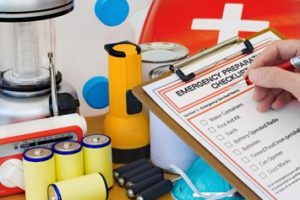The Federal Emergency Management Agency recognizes each September as National Preparedness Month. This is the perfect time to make sure that not only your household is prepared for disaster but also that your workplace is as well.
If your organization does not have plans such as these in place already, follow these steps to begin the process of preparing your workplace for natural disasters.
Assess Your Local Hazards
In order to best prepare, evaluate your area and determine which natural disasters could pose a threat. For example, if your office is located in Wichita, Kansas, it would better serve you to prepare for tornados rather than tsunamis. Don’t exclusively assess your locality, but take your office building into account as well. You’ll need to consider which floor your office is on, exit routes, hazards within your building, and more when creating your plans. Aside from personal dangers your company could experience, identify the ways in which your business would be impacted. This is critical for the planning process to bounce back after disaster hits.
Create Your Emergency Plans
Once you are aware of the potential threats your workplace could face, start creating plans to protect your organization and coworkers should a natural disaster occur. There are many components to organize, but every part is necessary to ensure the safety of your company. The first step to take is to create a plan to protect the workers. This includes what to do as the disaster hits as well as how to stay safe afterward. Find the most efficient way to have open communication among your team so everyone’s needs can be met. Next, decide how to keep your business running as smoothly as possible once an emergency occurs. Resources may be limited following the disaster, so ensure you have the priorities of the organization straight. Lastly, decide what will be done to recover from the incident—both for the employees and the business. Bouncing back from something like this is difficult for the company, but it will also likely take an emotional toll on your workers, and this must be taken into account. Once the plans are created and distributed to all workers, hold practice drills to test the communication systems and the mode of protection—whether it be leaving the building or designating a safe space on a higher level. Learn from these tests so you can improve response time and better protect all employees.
Prepare Emergency Kits
It’s likely that your company already has provisions available in the case of a medical emergency or an accident, but it’s essential to supplement these with supplies for disasters as well. If a circumstance such as a flash flood was to happen, and workers would not be able to travel, there should be supplies available to them. Some examples of items for these kits include food and water, a tool kit, a hand-crank radio, batteries, and personal hygiene items. At least once a year, you should go through the supplies and check if anything needs to be added or replaced.
Ensure Clear Communication
Having emergency plans in place won’t be worth much if you are not able to effectively communicate them within your organization. The last thing you want is chaos as a disaster approaches. Create high-priority text alerts or an alarm that everyone can clearly identify. Each workplace is unique, so find what works for your circumstances. There should also be a way for everyone to communicate back and forth after the warning has gone off so each person’s needs can be cared for.
Plan for Returning to Work
If a natural disaster was to happen at your workplace, you’ll want a plan for afterward prepared ahead of time. Of course, it’s impossible to know the details of what would happen, but you should have some steps in place to make the return to work operate as smoothly as possible. A critical part of this, which is often overlooked, is the emotional state of employees following the disaster. Not only is your workplace affected by natural disasters but it’s also likely that many workers’ homes and families were as well. Take this into consideration, and look into having a counselor available for employees to speak to. Now that you have a plan in place for emotional support, it’s important to have a general plan for continuing business. If possible, designate alternative workplaces for employees so work can continue even if your office building was impacted. Assign teams of staff members to take care of potential tasks after an event like this, such as obtaining more resources or assisting in cleanup. Hopefully, with these plans in place, your workplace can return to normalcy as soon as possible.
| Cameron Smith is the outreach coordinator and social media contributor (Twitter and Facebook) at SimpliSafe. Smith specializes in creating content related to preparedness and home security. Smith is passionate about speaking with community members about personal safety and has helped start multiple neighborhood watch programs in her community. |

